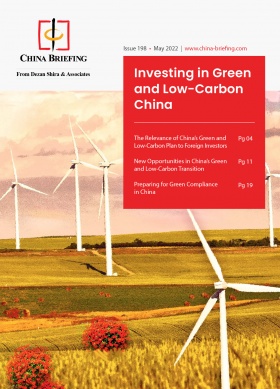China’s Energy Storage Sector: Policies and Investment Opportunities
Energy storage is crucial for China’s green transition, as the country needs an advanced, efficient, and affordable energy storage system to respond to the challenge in power generation. According to Trend Force, China’s energy storage market is expected to break through 100 gigawatt hours (GWh) by 2025. It is set to become the world’s fastest-growing energy storage market, overtaking Europe and the United States.
Why is energy storage important?
Energy storage refers to the process or device that captures energy produced for use at a later time to reduce imbalances between energy demand and production. It can provide a rich spectrum of benefits to the electric grid, to electricity end-users, and to society as a whole. As for China, energy storage offers sustainable solutions for more efficient use of energy.
While China’s renewable energy sector presents vast potential, the blistering pace of plant installation is not matched with their usage capacity, leading more and more clean energy to be wasted. Some provinces in the northwest region with rich wind and solar resources generally have an oversupply of electricity. Analysis shows that nearly 12 percent of power generated by wind turbines in Inner Mongolia and 10 percent of solar power in Qinghai this year has been wasted. In Gansu, due to low consumption capacity, the overall utilization rate of energy may drop below 90 percent, compared with 96.83 percent in 2021.
By saving surplus energy and releasing when the demand is higher, the energy storage sector will balance out the variability in power generation from renewables. In doing so, it will integrate more renewable sources into China’s energy systems and further facilitate the transition towards a carbon-neutral economy.
China’s current energy storage market
China’s renewable sector is currently experiencing rapid growth. According to data from the National Energy Administration (NEA), as of April, the country’s installed power generation capacity was about 2.41 billion kilowatts (KW), a year-on-year increase of 7.9 percent. China is aiming for 50 percent of its electricity generation from renewable power by 2025, a 42-percent increase from now. China also has one of the largest battery energy storage markets, with a total capacity around 70GW with a market value of US$1.2 billion in 2021, which is projected to increase to 170 GW with $6 billion by 2025.
China’s plan to develop energy storage
On March 21, 2022, the National Development and Reform Commission (NDRC) and the National Energy Administration (NEA) jointly released the Implementation Plan for the Development of New Energy Storage Technologies during the 14th Five-Year Plan Period (the 14th FYP for Energy Storage), which calls for a wider ecosystem of government and private entities to build the energy storage sector and emphasizes the role of market forces, including generation utilities and independent service providers, in investing in storage projects. By 2030, China plans to build up domestic capabilities in all core energy storage technologies to meet the needs of the future power system.
In the long run, energy storage will play an increasingly important role in China’s renewable sector. The 14th FYP for Energy Storage advocates for new technology breakthroughs and commercialization of the storage industry. Following the plan, more than 20 provinces have already announced plans to install energy storage systems over the past year, with the combined capacity of over 40 gigawatts.
The Plan has also made a clear goal to decrease the per unit cost of energy storage by 30 percent by 2025. Once these targets are met, the price can reach at RMB 0.8 to 1.0 (US$0.12 to 0.15) per watt-hour, making the energy storage system commercially viable without subsidies.
The Plan thus gives energy storage a path to market-driven growth and paves the way for large-scale deployment of energy storage in the power sector. From there, pricing mechanisms capable of making energy storage profitable will provide strong force to achieve carbon neutrality before 2060.
As diverse mechanisms can better meet different storage needs and duration requirements, the 14th FYP for Energy Storage outlines the collective development of various new energy storage technologies, such as compressed air, hydrogen, battery, and thermal energy, and aims for self-reliance in key fields. It also sets out ambitious targets for the development of 30GW from non-pumped hydro energy storage technologies as well as their commercialization and large-scale implementation.
Hydro energy storage
A primary source of clean energy, hydro technology possesses a huge generation potential of 680 GW in China, based on estimation from the NEA, which set a goal of attaining 180 GW with new constructions by 2025. PowerChina, the country’s largest builder of hydro power projects, plans to construct 200 pumped hydro stations with a combined capacity of 270 GW by 2025.
As for storage, the country aims to massively scale up to the capacity of 120 GW by 2030 from about 32 GW now by 2030. At the end of 2019, the entire world had 158 GW of hydro storage.
Provincial authorities also require developers of new renewable energy projects to invest in storage systems to take care of at least 10 to 30 percent of their projects’ needs.
Battery energy storage
China is investing heavily in battery storage, targeting 100 GW storage capacity by 2030. The 14th FYP set the tone to support all types of battery energy storage systems, including sodium-ion, novel lithium-ion, lead-carbon, and redox flow. Battery storages have the advantages of high capacity, long life cycles, low cost, and fast response times. The goal is to accelerate the build-out of independently owned battery storage facilities to help balance the rapidly growing but intermittent generation capacity from wind turbines and solar panels.
China has long dominated the global lithium battery supply chain, although Europe and the US are also making large strides to increase domestic production. In February, the Ministry of Industry and Information Technology (MIIT) revealed that China’s production output for lithium-ion batteries for energy storage reached 32GWh in 2021, 10 percent of its total lithium-ion battery output, in a market worth RMB 600 billion (US$89 billion).
Compressed air energy storage
On May 26, 2022, China’s first salt cavern compressed air energy storage started operations in Changzhou, Jiangsu province, marking significant progress in the research and application of China’s new energy storage technology. The power station uses electric energy to compress air into an underground salt cavern and then releases air to drive an air turbine, which can generate electricity when needed.
Co-developed by China National Salt Industry Group Co Ltd, China Huaneng Group, and Tsinghua University, the project has raised nearly RMB 336 million (US$50 million) in a funding round. When put into operation, the energy storage capacity in each cycle reaches 300,000 KWh of electricity, equal to the daily electricity consumption of about 60,000 residents.
Solar thermal energy storage
Efficient operation of solar thermal systems combined with thermal energy storage systems is the most important aspect for large-scale utilization of solar. China is forecasted to install 83 to 99 GW of solar power capacity annually through 2025, while the energy generated by solar farms rose 14 percent last year to 54.9 GW, according to the NEA. This amount of generation needs high storage capacity as well.
In March, China General Nuclear Power Corp began to construct its solar thermal storage integrated project in Delingha, Qinghai. With a total installed capacity of 2 million KW, the project is with the highest energy storage ratio of 25 percent in the country to date and can store energy for six hours.
What are the opportunities for foreign investors?
Investments in energy storage technologies will likely increase after China’s recent signals to boost capital spending to help stimulate the economy. Storage service providers will then become key business players. Under the favorable terms, the energy storage sector also demonstrates good investment outcome. Analysis forecasts an annual return rate of 15.6 percent for an energy storage system installed at a solar farm once the cost reduction target is reached. Additionally, as photovoltaic power plant projects are generally required to configure a certain proportion of energy storage facilities, the investment of photovoltaic power plants will also increase by five to 10 percent. These numbers reflect attractive investment opportunities.
In a joint statement posted in May, the NDRC and the NEA established their intentions to realize full the market-oriented development of new (non-hydro) energy storage by 2030 to boost renewable power consumption while ensuring stable operation of the electric grid system. More specifically, the authorities will allow energy companies to buy and sell electricity directly in China’s power markets, opening doors for more profitable energy storage investment. The sector’s supply chain will be further promoted to enable higher transparency of information and faster responsiveness to changes in industry supply and demand. The authorities also called for provincial authorities to create price mechanisms that can entice power companies to participate in the market.
The energy storage market presents significant opportunities for foreign investors, especially technology providers. China has set goals to boost its non-pumped hydro energy storage capacity to around 30GW by 2025 and 100GW by 2030 – a more than 3000 percent increase from 3.3GW in 2020. Achieving this goal would require enhanced government supports and vigorous investment to the sector, which is expected to drive the boom of the strategic energy storage industry.
According to current effective Catalogue of Industries for Encouraging Foreign Investment (2020 Version) and the proposed 2022 draft, foreign investors are generally not restricted to access this sector while R&D and application of large energy-storage technologies are especially encouraged for foreign investment. Moreover, the government is also actively promoting international cooperation through joint R&D, standards setting, infrastructure construction, etc.
Final takeaways
China started developing the energy storage economy after Europe, the US, Japan, and South Korea, but now, with the release of favorable policies, this process is accelerating very fast. China has set high ambitions to become a leader in energy storage and the window for foreign investors is open.
A critical part of the comprehensive power market reform, energy storage is an important tool to ensure the safe supply of energy and achieve green and low-carbon development in China’s modern energy system. Technological innovation and commercial application of the energy storage sector will enhance the competitiveness of the energy industry to achieve China’s dual carbon goals.
About Us
China Briefing is written and produced by Dezan Shira & Associates. The practice assists foreign investors into China and has done so since 1992 through offices in Beijing, Tianjin, Dalian, Qingdao, Shanghai, Hangzhou, Ningbo, Suzhou, Guangzhou, Dongguan, Zhongshan, Shenzhen, and Hong Kong. Please contact the firm for assistance in China at china@dezshira.com.
Dezan Shira & Associates has offices in Vietnam, Indonesia, Singapore, United States, Germany, Italy, India, and Russia, in addition to our trade research facilities along the Belt & Road Initiative. We also have partner firms assisting foreign investors in The Philippines, Malaysia, Thailand, Bangladesh.
- Previous Article China Insurance Premium Deferral: What Businesses Need to Know
- Next Article What Has Changed in China’s Amended Anti-Monopoly Law?







